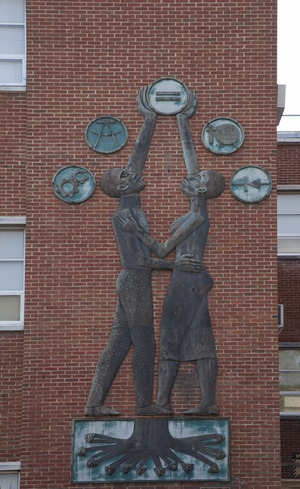Students Aspire facts for kids
Quick facts for kids Students Aspire |
|
|---|---|
 |
|
| Artist | Elizabeth Catlett |
| Year | 1977 |
| Type | Bronze |
| Dimensions | 426.72 cm × 140.208 cm (168.00 in × 55.200 in) |
| Location | Washington, D.C. |
| Owner | Howard University |
Students Aspire is an amazing outdoor sculpture by the American artist Elizabeth Catlett. You can find it at Howard University in Washington, D.C., in the United States. When the sculpture was finished, the university president, James E. Cheek, said it was a very important new piece of art for the campus.
Contents
What Does the Sculpture Look Like?
This sculpture is a bronze relief, which means it's a sculpture carved into a flat surface. It shows two African-American students, a boy and a girl, facing each other. They each have one hand on the other's waist. Their other hands are raised high above their heads.
Symbols in the Artwork
The students' raised hands are reaching towards a group of five round disks. These disks form an arch over the figures. Each disk has a symbol related to science or technology. Below the students, there's a square part that looks like the roots of a tree. At the end of each root, you can see a small face. The sculpture is signed "EC 77," which means Elizabeth Catlett made it in 1977.
Understanding the Sculpture's Message
Just below the sculpture, there is a plaque on the wall. It tells us who created the artwork and how it was made possible.
Plaque Details
The plaque reads:
- ELIZABETH CATLETT 1915–
- 1977
- THE SCULPTURE AND THE
- CHEMICAL ENGINEERING WING
- WERE MADE POSSIBLE BY A
- GRANT FROM THE
- EXXON EDUCATION FOUNDATION
This means that Elizabeth Catlett created the sculpture in 1977. Both the sculpture and the building's chemical engineering part were built with money from the Exxon Education Foundation.
How the Sculpture Was Created
The story of Students Aspire began with a special grant.
Funding the Art Project
In 1973, Howard University received a large grant of $600,000 from the Exxon Education Foundation. This money was used to build a new chemical engineering wing for the university's engineering building. Exxon then offered an extra $30,000 to pay for art in this new wing. This gift was approved in 1974.
Choosing the Artist
An art committee was formed to help choose the artist for this project. They invited 22 artists to take part, and 14 of them responded. Eight artists submitted sketches of their ideas, which were shown in the engineering building's lobby. Based on what people thought, four artists were then asked to create small models, called maquettes, of their proposed sculptures. These artists also came to the College of Engineering to talk about their ideas.
Elizabeth Catlett's Vision
In 1976, a vote was held. Students, teachers, and staff from the engineering school all voted for their favorite design. Elizabeth Catlett's artwork won the competition! The sculpture was officially dedicated on May 12, 1978. Geraldine Pittman Woods gave a speech at the dedication ceremony.
What the Artist Said About Her Work
Elizabeth Catlett explained the meaning behind Students Aspire in her own words.
Artist's Explanation
She said that the two students in the sculpture are holding each other up to show unity. This means they are working together and supporting each other, rather than competing. The equal sign in the sculpture represents both scientific and social equality. This means everyone should be treated equally, whether it's men and women, students and teachers, or people of different backgrounds.
Catlett also explained that the students form the trunk of a tree. The round medallions are like the branches, and the plaque at the bottom represents the roots. She was happy to hear ideas from the faculty and students. She listened to their thoughts and then used them in her own artistic way.
Condition of the Sculpture
In 1993, experts checked the sculpture to see how it was doing. They found that it needed some care to keep it in good shape.

